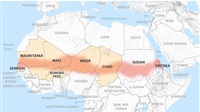In their own words: the protesters at the heart of America's uprising

It was a protest that sparked a wave of dissent
across the country, culminating in something never seen before: Americans
across all 50 states coming together to denounce police brutality and the
culture of impunity that shrouds their institution.
Last week, photographer Nina Robinson headed to the
streets of Minneapolis to capture this historical moment. “From the beginning,
there has been a profound lack in most coverage of how people are feeling, how
they are affected by the murder of George Floyd,” she says. “Coupled with that,
a lot of mainstream media appears to be solely concerned with destruction and
property. I wanted to know what the community of Minneapolis were feeling. I
wanted to make sure they were seen globally. People want to be heard, and it’s
imperative for all of us to listen.”
Angry, disappointed, exhausted … but more than
anything, just hurt. Because we all know somebody who’s been through the same
thing, or we know somebody who could possibly go through the same thing.
I have two teenage sons, I have a brother, I have a
boyfriend, a father. It just has to stop. This is home for me and seeing what
happened to Jamar Clark [who was fatally shot in Minneapolis in 2015], seeing
Philando Castile [who was fatally shot in St Paul, Minnesota, in 2019], and now
seeing this right here – where we’re supposed to be “Minnesota nice”.
Some people have turned a blind eye to racism, and
we’ve done that long enough. I want everybody to just stay vigilant. We can’t
get distracted. We have to stay the course. That’s the only way this is gonna
ever get resolved: if we just stay vigilant and stay the course.
I just got back to Minneapolis last night. You leave
your city in one condition and then, you come back and it’s in two different
conditions: one that you’re not used to but you don’t like seeing, and the
other, which is just destruction. I’m frustrated. I just don’t want this to
end, I don’t want it to go away – I want people to fight. I want people to
fight responsibly, fight safely and fight without violence if necessary. I want
them to come together. And I want them to not let this be the end of it right
here, on 38th and Chicago Avenue. I’m hoping that people are seeing what this
is, and how important it is for change.
I’ve been active each day as much as I can, whether
it’s protesting or passing out water. I’ve been down to Lake Street at Cub
Foods to clean up the streets. My friends have been organizing donation drives.
I just want people to know – this is national. This is not just about this one
situation. Philando Castile still never got his justice for what happened to
him.
This is our reality every day, whether people want
to face that or not. And it’s felt worldwide this time. It’s just beautiful to
see that solidarity everywhere else. It means a lot, for real. We just want to
be heard. We want our lives to matter. You know, we want to be treated like
everyone else.
I protested and I went out the first day after the
wreckage. I started noticing when I was out there that a lot of the damage
wasn’t done by us. Black people was getting a lot of the blame for a lot of
this damage that we didn’t even do. There was a specific set of people out
there who were white supremacists – I’m gonna call it what it is. That’s just
me. They were anarchists and white supremacists. And they had a completely
different agenda. I saw white people out there burning stuff up and then spray
painting Black Lives Matter. It made me mad. All that stuff blowing up? That
wasn’t us. And that didn’t have nothing to do with Floyd or his memory or his
legacy, period. And that’s what kind of gets me a little bit emotional.
A lot of people are scared to speak about white
supremacy on any level. That’s why I applaud our mayor, Jacob Frey, who called
white supremacy out, I applaud our governor, Tim Walz, for calling white
supremacy out and admitting that he knew that this was white supremacists who
was destroying and trying to burn down our towns.







